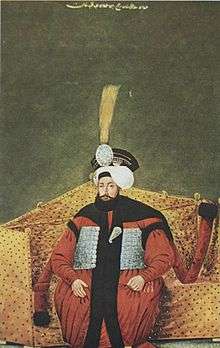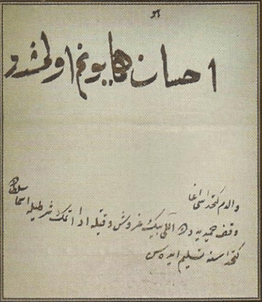Mustafa IV
Mustafa IV (/ˈmʊstəfə/; Ottoman Turkish: مصطفى رابع Muṣṭafā-yi rābi‘; 8 September 1779 – 16 November 1808) was the Sultan of the Ottoman Empire from 1807 to 1808.
| Mustafa IV مصطفى رابع | |||||
|---|---|---|---|---|---|
| Ottoman Caliph Amir al-Mu'minin Sultan of the Ottoman Empire Kayser-i Rûm Custodian of the Two Holy Mosques | |||||
 | |||||
| 29th Ottoman Sultan (Emperor) | |||||
| Reign | 29 May 1807 – 28 July 1808 | ||||
| Predecessor | Selim III | ||||
| Successor | Mahmud II | ||||
| Born | 8 September 1779 Constantinople, Ottoman Empire (present day Istanbul, Turkey) | ||||
| Died | 16 November 1808 (aged 29) Constantinople, Ottoman Empire | ||||
| Burial | Fatih, Istanbul | ||||
| Consorts | Şevkinur Kadın Dilpezır Kadın Seyyare Kadın | ||||
| Issue | Emine Sultan | ||||
| |||||
| Dynasty | Ottoman | ||||
| Father | Abdul Hamid I | ||||
| Mother | Sineperver Sultan | ||||
| Religion | Sunni Islam | ||||
| Tughra | |||||

Early life
Born in Constantinople, Mustafa IV was the son of Sultan Abdul Hamid I (1774–1789) and Sineperver Sultan.[1]
Both he and his brother, Mahmud II, were the last remaining male members of the house of Osman I after their cousin, the reformist Sultan Selim III (1789–1807). They alone were therefore eligible to inherit the throne from Selim, by whom they were treated favorably. Since Mustafa was the elder, he took precedence over his brother to the throne.[2] During his short reign, Mustafa would both save his cousin's life, and order him murdered. Mustafa was Sultan Selim III's favourite crown prince, but he deceived his cousin and co-operated with the rebels to take his throne.
Reign
Mustafa came to the throne in the wake of the turbulent events that led to the fatwa against Selim for "introduce[ing] among the Moslems the manners of infidels and show[ing] an intention to suppress the Janissaries."[3] Selim fled to the palace, where he swore fealty to his cousin as the new sultan, and attempted to commit suicide. Mustafa spared his life by smashing the cup of poison that his cousin attempted to drink.[3]
Mustafa's brief reign was turbulent. Immediately upon ascending to the throne, the Janissaries rioted throughout Constantinople, looting and murdering anyone who appeared to support Selim.[4] More threatening, however, was a truce signed with the Russians, which freed Mustafa Bayrakdar, a pro-reformist commander stationed on the Danube to march his army back to Constantinople in an effort to restore Selim. With the aid of the Grand Vizier of Adrianople, the army marched on the capital and seized the palace.[3]
Sarıbeyzade Aleko, the interpreter of Fenerli Divan-ı Hümayun, was executed on 11 September 1807 because he was involved in spying on government affairs that were not related to his job and spying. It was written that he gave the betrayal and state secrets to the enemy in the label hanging around his neck. This execution tightened Ottoman-French relations. French envoy Sebastiani protested the execution of Aleko, who was under the patronage of the government by going to Babıali. After the cease-fire agreement signed in the Russian lada and the turmoil in the Silistra army, the Ottoman troops returned to Edirne, who had no army character left. [5]
Meanwhile, in Istanbul and Edirne, after a long winter, centre frosts were experienced, shortages and wood shortages were experienced. The situation of the troops and the cadre of Edirne was devastated. Soldiers were asked to dispatch soldiers from the provincial governors, until only a exquisite number of soldiers had come from a few places near Istanbul such as Izmit and Şile. The pro-Nizam-ı Cedid protestors in Anatolia and Çapanoğlu Süleyman Bey, in the first place, had cut all kinds of aid towards Istanbul. [6]
Attempting to secure his position by positing himself as the only surviving heir of Osman, Mustafa ordered both Selim and his brother Mahmud murdered at Topkapı Palace, Constantinople. He then ordered his guards to show the rebels Selim's body,[4] and they promptly tossed it into the inner courtyard of the palace. Mustafa then ascended his throne, assuming that Mahmud was also dead, but the prince had been hiding in the furnace of a bath.[7] Just as the rebels demanded that Mustafa "yield his place to a worthier," Mahmud revealed himself, and Mustafa was deposed. The failure of his short reign prevented the efforts to undo the reforms, which continued under Mahmud.
Death
Mustafa was later killed on Mahmud's orders on 16 November 1808, and was buried in his father's mausoleum.
Family
- Consorts
- Şevkinur Kadın (died 1812, buried in Abdul Hamid I Mausoleum, Istanbul), the principal consort;[8]
- Seyyare Kadın (died 1817, buried in Abdul Hamid I Mausoleum, Istanbul), the second consort;[8]
- Dilpezır Kadın (died 1809, Abdul Hamid I Mausoleum, Istanbul), the third consort [9]
- Children
- Emine Sultan (6 May 1808 – 9 November 1808);
References
- Yavuz Bahadıroğlu, Resimli Osmanlı Tarihi, Nesil Yayınları (Ottoman History with Illustrations, Nesil Publications), 15th Ed., 2009, page 395, ISBN 978-975-269-299-2
- Lord Kinross, The Ottoman Centuries: The Rise and Fall of the Turkish Empire, Perennial, 1977, p. 437. ISBN 0-688-03093-9.
- Kinross, p. 433.
- Goodwin, p. 291.
- Sakaoğlu 2015, p. 380.
- Sakaoğlu 2015, p. 381.
- Kinross, p. 434.
- Ziya, Mehmet (2004). Istanbul ve Boğaziçi: Bizans ve Osmanlı medeniyetlerinin Ölümsüz Mirası, Volume 1. BIKA.
- Uluçay 2011, p. 176.
External links

- http://www.uslanmam.com/turk-kulturu/651298-sultan-i-abdulhamid-turbesi-eminonu.html
Mustafa IV House of Osman Born: 8 September 1779 Died: 15 November 1808 | ||
| Regnal titles | ||
|---|---|---|
| Preceded by Selim III |
Sultan of the Ottoman Empire 29 May 1807 – 15 November 1808 |
Succeeded by Mahmud II |
| Sunni Islam titles | ||
| Preceded by Selim III |
Caliph of the Ottoman Caliphate 29 May 1807 – 15 November 1808 |
Succeeded by Mahmud II |
